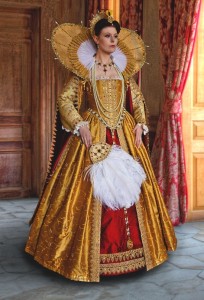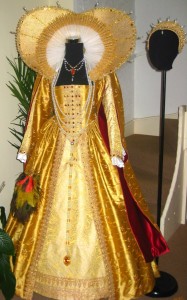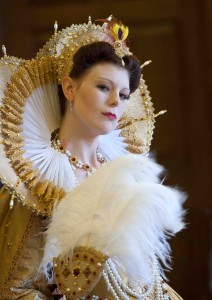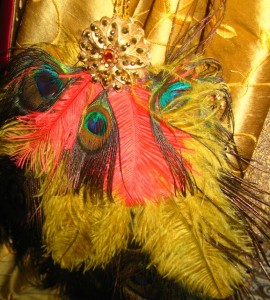
This beautiful and ornate gown was inspired by possibly the greatest Monarch of England – Queen Elizabeth I. This gown has been inspired by portraits of Elizabeth and costumes worn by Helen Mirren in the TV drama series Elizabeth as well as Cate Blanchett and Judi Dench.. It is a theatrical costume designed to show her power and status.
Elizabeth’s image was carefully engineered to impress and to convey wealth, authority and power. Her wardrobes was full of gowns of rich fabrics adorned with jewels and elaborate surface detail, which were clearly imposing and speak volumes about wealth and status. At her death, over 2000 gowns were recorded in Elizabeth’s wardrobe.
As the nation’s most powerful woman, Elizabeth’s taste set the ‘look’ of the day, especially for the aristocracy. Many of the women around her at court wore the narrow waisted, full sleeved, large-ruffed, full-skirted style of her later years.
Being beautiful in Tudor times was a risky business, especially in the time of Elizabeth I. Fashionable women had a pale face to show they were noble and rich, and did not work in the sun. Their cheeks were pink with rouge, their lips were red, their teeth white and their hair auburn or fair. They had elegant arched eyebrows and a high hairline.
To achieve this look, they had to use make up and dyes that were bad for their skin. To get their fashionable white complexions women ground up white lead and mixed it with vinegar to make a paste called ceruse.
They put white make up on to cover their chests as well if they wore low-cut dresses, and even painted pale blue veins on top of the make-up to show how fine their skin was. Lead is poisonous. Some people noticed at the time that it made the skin look grey and shrivelled. There were women who plastered on their make-up so thickly that it cracked if they moved their faces.
Red lipstick and rouge were called fucus. This was made from a pigment like red sandalwood, mercury sulphide or cochineal mixed with egg whites, green fig milk and gum Arabic, which comes from trees. Women could wear a wig or dye their hair. One hair dye recipe uses concentrated sulphuric acid, which is extremely dangerous.Elizabeth was tall and striking, with pale skin and light red-gold hair. She exaggerated these features, particularly as she aged, and other women sought to emulate them. Queen Elizabeth almost died of Smallpox in 1562 so was left with scars on her face – these were covered with the heavy white make-up which was fashionable at the time. Elizabeth’s curly red hair presented challenges as women tried to achieve the same look. Red wigs became a popular alternative, which Elizabeth also took to wearing. As Elizabeth aged her teeth to decay. Her influence by this time was so all-pervasive that some women even went so far as to blacken theirs to mimic her appearance!

No Queen would be seen at court without her lavish jewellery. A heavy three row pearl necklace is worn – Elizabeth loved pearls and this type of necklace can be seen in many of her portraits. She also wears a pearl and gold necklace with a large ruby/orange jewel and a pearl and jewel girdle with a pendant.
A beautiful peacock fan embellished with gold completes this lavish outfit.
We cannot display this gallery



A Beautiful Gown – I love it!
What a beautiful gown. The quality shows the many hours that you have put into this gown. I am stunned, thrilled to see another gold gown (although mine looks like a cheap costume compared to this). I am blown away. I could run out of space writing compliments on this stunning costume. One question I do have is how you did the ruff, I can’t seem to get mine to behave correctly (not enough starch maybe?). Again, amazing work, I will pin it to Pinterest to get you more views, this absolutely deserves it.
Hi Sarah
Nice to hear from – really pleased you like my gold gown.
Regarding the ruff –
I created it by firstly hemming the sides and bottom edge of a very long double strip of silk organza (the stiffest you can find) – keeping the fold at the top edge (If you need extra support you could stitch a long piece of very stiff dress net to the back). Then I stitched gold lace along the top edge.
The strip was cartridge pleated and sewn to a neckband.
As the ruff is quite large and heavy it sits against a gold wisk (wings) which I have decorated with pearls, lace and jewels.
If you don’t create a wisk you will have to make a supportasse or a large and heavy ruff may not stand up properly.
Have a look at the very merry seamstress website – it has a lot of useful information about ruffs/wisks etc.
http://www.verymerryseamstress.com/ruff.htm
You can also find a pattern for a supportasse by Margo Anderson (although I haven’t used it).
http://www.margospatterns.com/Products/ElizAccessrs.html
Hope this is of some help
Kind regards
Julia
What a fabulous Elizabethan Gold Gown – I’d really love to wear it – always wanted to be Elizabeth I – it’s been a dream of mine.
I love this Gown – it is beautiful – What stunning fabric!